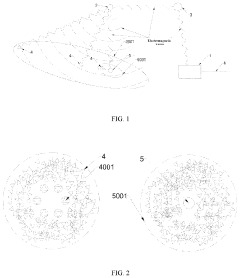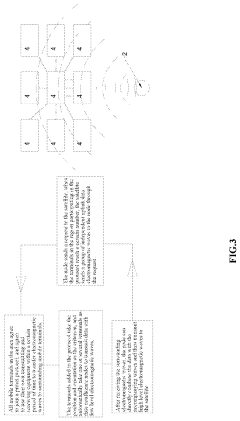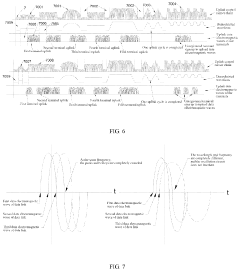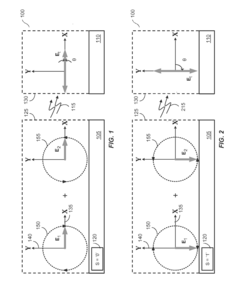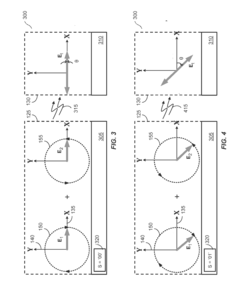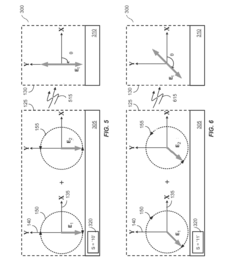Improving Data Transmission Using Electromagnetic Waves
JUL 11, 20259 MIN READ
Generate Your Research Report Instantly with AI Agent
Patsnap Eureka helps you evaluate technical feasibility & market potential.
EM Wave Tech Evolution
The evolution of electromagnetic wave technology for improving data transmission has been a journey of continuous innovation and breakthroughs. This technological progression can be traced back to the late 19th century when Heinrich Hertz first demonstrated the existence of electromagnetic waves, laying the foundation for wireless communication.
In the early 20th century, the development of radio technology marked a significant milestone in data transmission using electromagnetic waves. The invention of amplitude modulation (AM) and frequency modulation (FM) techniques enabled the transmission of audio signals over long distances, revolutionizing mass communication.
The mid-20th century saw the advent of microwave communication systems, which utilized higher frequency electromagnetic waves to transmit data over line-of-sight paths. This technology played a crucial role in long-distance telephone networks and early satellite communications.
The 1960s and 1970s witnessed the emergence of fiber-optic communication, which, although not directly using electromagnetic waves in free space, employed light waves for data transmission. This technology dramatically increased data transmission capacity and speed, becoming the backbone of modern telecommunications networks.
The late 20th century brought about the mobile revolution with the development of cellular networks. Starting from the first generation (1G) analog systems, the technology rapidly evolved through 2G, 3G, and 4G, each generation improving data transmission rates and capabilities.
The early 21st century has been characterized by the pursuit of ever-higher data transmission speeds and capacity. The development of advanced modulation techniques, multiple-input multiple-output (MIMO) systems, and beamforming technologies has pushed the boundaries of what is possible with electromagnetic wave-based data transmission.
Currently, we are witnessing the rollout of 5G networks, which promise unprecedented data rates, ultra-low latency, and massive device connectivity. This technology leverages higher frequency bands, including millimeter waves, to achieve its performance goals.
Looking ahead, researchers are already exploring the potential of terahertz waves and even visible light communication (Li-Fi) for future data transmission systems. These technologies could potentially offer even higher data rates and open up new applications in areas such as short-range, high-bandwidth communications.
Throughout this evolution, the fundamental goal has remained constant: to improve the efficiency, speed, and reliability of data transmission using electromagnetic waves. Each technological advancement has built upon previous innovations, pushing the limits of what is possible and continually reshaping our connected world.
In the early 20th century, the development of radio technology marked a significant milestone in data transmission using electromagnetic waves. The invention of amplitude modulation (AM) and frequency modulation (FM) techniques enabled the transmission of audio signals over long distances, revolutionizing mass communication.
The mid-20th century saw the advent of microwave communication systems, which utilized higher frequency electromagnetic waves to transmit data over line-of-sight paths. This technology played a crucial role in long-distance telephone networks and early satellite communications.
The 1960s and 1970s witnessed the emergence of fiber-optic communication, which, although not directly using electromagnetic waves in free space, employed light waves for data transmission. This technology dramatically increased data transmission capacity and speed, becoming the backbone of modern telecommunications networks.
The late 20th century brought about the mobile revolution with the development of cellular networks. Starting from the first generation (1G) analog systems, the technology rapidly evolved through 2G, 3G, and 4G, each generation improving data transmission rates and capabilities.
The early 21st century has been characterized by the pursuit of ever-higher data transmission speeds and capacity. The development of advanced modulation techniques, multiple-input multiple-output (MIMO) systems, and beamforming technologies has pushed the boundaries of what is possible with electromagnetic wave-based data transmission.
Currently, we are witnessing the rollout of 5G networks, which promise unprecedented data rates, ultra-low latency, and massive device connectivity. This technology leverages higher frequency bands, including millimeter waves, to achieve its performance goals.
Looking ahead, researchers are already exploring the potential of terahertz waves and even visible light communication (Li-Fi) for future data transmission systems. These technologies could potentially offer even higher data rates and open up new applications in areas such as short-range, high-bandwidth communications.
Throughout this evolution, the fundamental goal has remained constant: to improve the efficiency, speed, and reliability of data transmission using electromagnetic waves. Each technological advancement has built upon previous innovations, pushing the limits of what is possible and continually reshaping our connected world.
Market Demand Analysis
The market demand for improved data transmission using electromagnetic waves has been experiencing significant growth across various sectors. This surge is primarily driven by the increasing need for faster, more reliable, and efficient communication systems in our increasingly connected world.
In the telecommunications industry, the demand for enhanced data transmission technologies is particularly pronounced. With the ongoing rollout of 5G networks and the anticipation of 6G, there is a pressing need for advanced electromagnetic wave technologies that can support higher data rates, lower latency, and improved spectral efficiency. This demand is further amplified by the exponential growth in mobile data traffic, which is expected to continue its upward trajectory in the coming years.
The Internet of Things (IoT) sector is another major driver of market demand for improved electromagnetic wave-based data transmission. As the number of connected devices continues to proliferate, there is a growing need for robust and energy-efficient communication technologies that can support the massive scale of IoT deployments. This includes applications in smart cities, industrial IoT, and consumer electronics, all of which require reliable and high-performance data transmission capabilities.
In the automotive industry, the development of connected and autonomous vehicles is creating a substantial demand for advanced electromagnetic wave technologies. These vehicles rely heavily on real-time data transmission for navigation, safety features, and vehicle-to-everything (V2X) communication. The market for these technologies is expected to grow significantly as autonomous driving capabilities continue to advance.
The aerospace and defense sectors also represent a significant market for improved electromagnetic wave-based data transmission. There is a growing need for secure, high-bandwidth communication systems for military applications, satellite communications, and unmanned aerial vehicles (UAVs). These applications often require specialized electromagnetic wave technologies that can operate in challenging environments and over long distances.
In the healthcare sector, the rise of telemedicine and remote patient monitoring is driving demand for reliable and high-speed data transmission technologies. This includes applications such as real-time video consultations, remote surgery, and the transmission of large medical imaging files. The COVID-19 pandemic has further accelerated this trend, highlighting the importance of robust telecommunication infrastructure in healthcare delivery.
The financial services industry is another sector where the demand for improved data transmission is growing. High-frequency trading, real-time fraud detection, and secure transaction processing all require ultra-low latency and high-reliability communication systems. As financial markets become increasingly digitized and globalized, the need for advanced electromagnetic wave technologies in this sector is expected to continue growing.
In the telecommunications industry, the demand for enhanced data transmission technologies is particularly pronounced. With the ongoing rollout of 5G networks and the anticipation of 6G, there is a pressing need for advanced electromagnetic wave technologies that can support higher data rates, lower latency, and improved spectral efficiency. This demand is further amplified by the exponential growth in mobile data traffic, which is expected to continue its upward trajectory in the coming years.
The Internet of Things (IoT) sector is another major driver of market demand for improved electromagnetic wave-based data transmission. As the number of connected devices continues to proliferate, there is a growing need for robust and energy-efficient communication technologies that can support the massive scale of IoT deployments. This includes applications in smart cities, industrial IoT, and consumer electronics, all of which require reliable and high-performance data transmission capabilities.
In the automotive industry, the development of connected and autonomous vehicles is creating a substantial demand for advanced electromagnetic wave technologies. These vehicles rely heavily on real-time data transmission for navigation, safety features, and vehicle-to-everything (V2X) communication. The market for these technologies is expected to grow significantly as autonomous driving capabilities continue to advance.
The aerospace and defense sectors also represent a significant market for improved electromagnetic wave-based data transmission. There is a growing need for secure, high-bandwidth communication systems for military applications, satellite communications, and unmanned aerial vehicles (UAVs). These applications often require specialized electromagnetic wave technologies that can operate in challenging environments and over long distances.
In the healthcare sector, the rise of telemedicine and remote patient monitoring is driving demand for reliable and high-speed data transmission technologies. This includes applications such as real-time video consultations, remote surgery, and the transmission of large medical imaging files. The COVID-19 pandemic has further accelerated this trend, highlighting the importance of robust telecommunication infrastructure in healthcare delivery.
The financial services industry is another sector where the demand for improved data transmission is growing. High-frequency trading, real-time fraud detection, and secure transaction processing all require ultra-low latency and high-reliability communication systems. As financial markets become increasingly digitized and globalized, the need for advanced electromagnetic wave technologies in this sector is expected to continue growing.
Current Challenges
The current challenges in improving data transmission using electromagnetic waves are multifaceted and complex. One of the primary obstacles is the increasing demand for higher data rates, which puts significant pressure on existing electromagnetic spectrum resources. As more devices and applications require wireless connectivity, the available frequency bands become increasingly congested, leading to interference and reduced transmission quality.
Signal attenuation and path loss present another significant challenge, particularly in urban environments and over long distances. Electromagnetic waves are susceptible to absorption, reflection, and scattering by various materials and obstacles, resulting in signal degradation and reduced transmission range. This issue becomes more pronounced at higher frequencies, which are often necessary for achieving higher data rates.
The need for improved energy efficiency in data transmission systems poses an additional challenge. As the volume of data transmitted continues to grow exponentially, the power consumption of transmission equipment becomes a critical concern. Developing more energy-efficient modulation and coding techniques, as well as optimizing power management in transmitters and receivers, is essential for sustainable growth in data transmission capabilities.
Security and privacy concerns also present significant challenges in electromagnetic wave-based data transmission. As wireless communication becomes ubiquitous, protecting sensitive information from interception and unauthorized access becomes increasingly important. Developing robust encryption and authentication methods that can be efficiently implemented in wireless systems is crucial for ensuring the integrity and confidentiality of transmitted data.
The dynamic nature of wireless channels adds another layer of complexity to data transmission improvements. Factors such as mobility, multipath fading, and environmental changes can cause rapid fluctuations in channel conditions, requiring adaptive transmission techniques and advanced signal processing algorithms to maintain reliable communication links.
Spectrum management and regulatory challenges also play a significant role in the advancement of data transmission using electromagnetic waves. The allocation of frequency bands is subject to strict regulations, and the process of obtaining new spectrum for emerging technologies can be time-consuming and complex. Balancing the needs of various stakeholders while ensuring efficient use of the limited spectrum resources remains an ongoing challenge.
Lastly, the integration of electromagnetic wave-based data transmission with emerging technologies such as 5G, Internet of Things (IoT), and machine-to-machine (M2M) communication presents its own set of challenges. These applications often require ultra-low latency, high reliability, and the ability to support massive numbers of connected devices simultaneously, pushing the boundaries of current transmission technologies and necessitating innovative solutions.
Signal attenuation and path loss present another significant challenge, particularly in urban environments and over long distances. Electromagnetic waves are susceptible to absorption, reflection, and scattering by various materials and obstacles, resulting in signal degradation and reduced transmission range. This issue becomes more pronounced at higher frequencies, which are often necessary for achieving higher data rates.
The need for improved energy efficiency in data transmission systems poses an additional challenge. As the volume of data transmitted continues to grow exponentially, the power consumption of transmission equipment becomes a critical concern. Developing more energy-efficient modulation and coding techniques, as well as optimizing power management in transmitters and receivers, is essential for sustainable growth in data transmission capabilities.
Security and privacy concerns also present significant challenges in electromagnetic wave-based data transmission. As wireless communication becomes ubiquitous, protecting sensitive information from interception and unauthorized access becomes increasingly important. Developing robust encryption and authentication methods that can be efficiently implemented in wireless systems is crucial for ensuring the integrity and confidentiality of transmitted data.
The dynamic nature of wireless channels adds another layer of complexity to data transmission improvements. Factors such as mobility, multipath fading, and environmental changes can cause rapid fluctuations in channel conditions, requiring adaptive transmission techniques and advanced signal processing algorithms to maintain reliable communication links.
Spectrum management and regulatory challenges also play a significant role in the advancement of data transmission using electromagnetic waves. The allocation of frequency bands is subject to strict regulations, and the process of obtaining new spectrum for emerging technologies can be time-consuming and complex. Balancing the needs of various stakeholders while ensuring efficient use of the limited spectrum resources remains an ongoing challenge.
Lastly, the integration of electromagnetic wave-based data transmission with emerging technologies such as 5G, Internet of Things (IoT), and machine-to-machine (M2M) communication presents its own set of challenges. These applications often require ultra-low latency, high reliability, and the ability to support massive numbers of connected devices simultaneously, pushing the boundaries of current transmission technologies and necessitating innovative solutions.
Existing Solutions
01 Wireless power transmission systems
These systems use electromagnetic waves to transmit power wirelessly. They often involve resonant circuits, coils, and antennas to efficiently transfer energy over distances. Applications include charging electronic devices and powering IoT sensors.- Wireless power transmission systems: These systems use electromagnetic waves to transmit power wirelessly. They typically involve transmitters and receivers designed to efficiently transfer energy over distances, enabling the charging of devices without physical connections. The technology often incorporates resonant coupling and adaptive tuning to optimize power transfer efficiency.
- Antenna designs for electromagnetic wave transmission: Advanced antenna designs are crucial for effective electromagnetic wave transmission in data communication systems. These may include phased array antennas, MIMO configurations, and adaptive beamforming techniques to enhance signal strength, directionality, and overall system performance in various environments and applications.
- Modulation and encoding techniques for data transmission: Various modulation and encoding methods are employed to improve the efficiency and reliability of data transmission using electromagnetic waves. These techniques may include advanced digital modulation schemes, error correction coding, and spread spectrum technologies to enhance data rates, reduce interference, and improve signal quality in challenging conditions.
- Electromagnetic wave-based sensing and communication in specific environments: Specialized systems are developed for electromagnetic wave-based sensing and communication in challenging environments such as underground, underwater, or in industrial settings. These systems often incorporate novel signal processing techniques, adaptive algorithms, and robust hardware designs to overcome environmental obstacles and ensure reliable data transmission.
- Integration of electromagnetic wave technology in IoT and smart systems: Electromagnetic wave-based communication is increasingly integrated into Internet of Things (IoT) devices and smart systems. This involves developing low-power, compact transceivers, implementing efficient networking protocols, and creating seamless interfaces between wireless communication systems and various sensors or actuators in smart environments.
02 Antenna designs for electromagnetic wave transmission
Various antenna designs are employed to optimize the transmission and reception of electromagnetic waves. These include phased array antennas, metamaterial antennas, and adaptive antenna systems that can adjust their properties based on environmental conditions or signal requirements.Expand Specific Solutions03 Modulation techniques for data transmission
Advanced modulation techniques are used to encode data onto electromagnetic waves for efficient transmission. These methods include various forms of amplitude, frequency, and phase modulation, as well as more complex schemes like OFDM (Orthogonal Frequency Division Multiplexing) to increase data rates and spectral efficiency.Expand Specific Solutions04 Electromagnetic interference mitigation
Techniques and systems are developed to reduce electromagnetic interference in data transmission. These include shielding methods, filtering techniques, and adaptive algorithms that can identify and mitigate sources of interference, ensuring reliable data transmission in noisy environments.Expand Specific Solutions05 Underwater electromagnetic communication
Specialized systems are designed for electromagnetic wave propagation and data transmission in underwater environments. These systems overcome the challenges of signal attenuation in water and often use low-frequency electromagnetic waves or hybrid acoustic-electromagnetic approaches for improved communication range and reliability.Expand Specific Solutions
Key Industry Players
The electromagnetic wave data transmission technology market is in a growth phase, with increasing demand driven by the proliferation of wireless devices and IoT applications. The global market size is projected to reach significant figures in the coming years. Technologically, the field is advancing rapidly, with major players like Huawei, Sony, and Samsung leading innovation. These companies are investing heavily in R&D to improve data transmission speeds, efficiency, and reliability. Other key players such as Nokia, Infineon, and Intel are also making substantial contributions, particularly in areas like 5G technology and semiconductor advancements for improved signal processing. The competitive landscape is intense, with both established tech giants and specialized firms vying for market share and technological breakthroughs.
Huawei Technologies Co., Ltd.
Technical Solution: Huawei has developed advanced 5G technology for improving data transmission using electromagnetic waves. Their approach includes massive MIMO (Multiple-Input Multiple-Output) technology, which uses large antenna arrays to focus energy in specific directions, significantly improving signal strength and data rates[1]. Huawei has also implemented beamforming techniques to enhance signal quality and reduce interference in crowded network environments[2]. Additionally, they have developed innovative modulation schemes that increase spectral efficiency, allowing for higher data throughput within the same bandwidth[3]. Huawei's solutions also incorporate advanced error correction algorithms and adaptive coding to maintain reliable connections even in challenging conditions[4].
Strengths: Industry-leading 5G technology, high spectral efficiency, and robust error correction. Weaknesses: Potential security concerns in some markets, reliance on global semiconductor supply chains.
Nokia Technologies Oy
Technical Solution: Nokia has made significant strides in improving data transmission using electromagnetic waves through their ReefShark chipsets and AirScale radio access solutions. Their technology implements advanced beamforming techniques, allowing for precise control of radio wave direction and energy[5]. Nokia's solutions also utilize Massive MIMO technology, enabling multiple data streams to be transmitted simultaneously, thereby increasing capacity and spectral efficiency[6]. They have developed innovative signal processing algorithms that enhance the quality of received signals, reducing interference and improving overall network performance[7]. Additionally, Nokia has implemented dynamic spectrum sharing, allowing for efficient use of available frequency bands across different generations of cellular technology[8].
Strengths: Strong presence in 5G infrastructure, advanced signal processing capabilities. Weaknesses: Facing intense competition in the telecom equipment market, slower adoption in some regions.
Core Innovations
Method and System for Electromagnetic Wave Data Transmission
PatentActiveUS20210119693A1
Innovation
- A system comprising a ground main information node, communication satellite, relay satellite, and uplink control carrier, utilizing independent electromagnetic waves and adaptive modulation to enhance data transmission speed and security, while reducing interference and energy consumption by employing multiple antenna emission units and position referencing techniques.
Dynamic Polarization Modulation and Control
PatentActiveUS20150304094A1
Innovation
- A method and system for transmitting data through polarization modulation of electromagnetic waves, utilizing a combination of circular and linear polarizations to create a third polarization that can be modulated based on data, allowing for simultaneous transmission of multiple independent data streams and enhanced security by adapting to receiver orientation.
Spectrum Regulations
Spectrum regulations play a crucial role in the improvement of data transmission using electromagnetic waves. These regulations are established by national and international bodies to manage the use of radio frequency spectrum, ensuring efficient and interference-free communication across various applications.
The International Telecommunication Union (ITU) serves as the primary global authority for spectrum allocation. It divides the world into three regions and coordinates spectrum usage to prevent cross-border interference. National regulatory bodies, such as the Federal Communications Commission (FCC) in the United States, further refine these allocations to meet specific country needs.
Spectrum regulations typically define frequency bands for different services, including mobile communications, broadcasting, and satellite operations. They also set power limits, emission standards, and licensing requirements to maintain order in the electromagnetic spectrum.
In recent years, the increasing demand for wireless data transmission has led to significant changes in spectrum regulations. Many countries have implemented spectrum reallocation initiatives, moving services from less efficient to more advanced technologies. For instance, the transition from analog to digital television broadcasting has freed up valuable spectrum for mobile broadband services.
Dynamic spectrum access and cognitive radio technologies are emerging as potential solutions to spectrum scarcity. These approaches allow for more flexible and efficient use of the spectrum by enabling devices to adapt their transmission parameters based on the current spectrum environment.
Regulatory bodies are also exploring new spectrum sharing models. The Citizens Broadband Radio Service (CBRS) in the United States is an example of a three-tiered sharing framework that allows for more efficient use of spectrum while protecting incumbent users.
As data transmission demands continue to grow, particularly with the advent of 5G and IoT technologies, spectrum regulations are evolving to accommodate these needs. This includes opening up higher frequency bands, such as millimeter-wave spectrum, for mobile communications and exploring innovative licensing schemes.
However, spectrum regulation faces challenges in balancing competing interests and keeping pace with rapid technological advancements. Harmonizing regulations across borders, addressing security concerns, and ensuring fair access to spectrum resources are ongoing issues that regulators must navigate.
In conclusion, spectrum regulations are a critical factor in improving data transmission using electromagnetic waves. They provide the framework for efficient spectrum utilization, foster innovation, and support the growing demand for wireless connectivity. As technology continues to evolve, so too must the regulatory landscape to enable the next generation of wireless communications.
The International Telecommunication Union (ITU) serves as the primary global authority for spectrum allocation. It divides the world into three regions and coordinates spectrum usage to prevent cross-border interference. National regulatory bodies, such as the Federal Communications Commission (FCC) in the United States, further refine these allocations to meet specific country needs.
Spectrum regulations typically define frequency bands for different services, including mobile communications, broadcasting, and satellite operations. They also set power limits, emission standards, and licensing requirements to maintain order in the electromagnetic spectrum.
In recent years, the increasing demand for wireless data transmission has led to significant changes in spectrum regulations. Many countries have implemented spectrum reallocation initiatives, moving services from less efficient to more advanced technologies. For instance, the transition from analog to digital television broadcasting has freed up valuable spectrum for mobile broadband services.
Dynamic spectrum access and cognitive radio technologies are emerging as potential solutions to spectrum scarcity. These approaches allow for more flexible and efficient use of the spectrum by enabling devices to adapt their transmission parameters based on the current spectrum environment.
Regulatory bodies are also exploring new spectrum sharing models. The Citizens Broadband Radio Service (CBRS) in the United States is an example of a three-tiered sharing framework that allows for more efficient use of spectrum while protecting incumbent users.
As data transmission demands continue to grow, particularly with the advent of 5G and IoT technologies, spectrum regulations are evolving to accommodate these needs. This includes opening up higher frequency bands, such as millimeter-wave spectrum, for mobile communications and exploring innovative licensing schemes.
However, spectrum regulation faces challenges in balancing competing interests and keeping pace with rapid technological advancements. Harmonizing regulations across borders, addressing security concerns, and ensuring fair access to spectrum resources are ongoing issues that regulators must navigate.
In conclusion, spectrum regulations are a critical factor in improving data transmission using electromagnetic waves. They provide the framework for efficient spectrum utilization, foster innovation, and support the growing demand for wireless connectivity. As technology continues to evolve, so too must the regulatory landscape to enable the next generation of wireless communications.
Energy Efficiency
Energy efficiency is a critical aspect of improving data transmission using electromagnetic waves. As the demand for data transmission continues to grow exponentially, the need for energy-efficient solutions becomes increasingly important. The current focus in this field is on developing technologies that can transmit more data while consuming less power.
One of the primary approaches to enhancing energy efficiency in electromagnetic wave-based data transmission is through the optimization of modulation schemes. Advanced modulation techniques, such as Quadrature Amplitude Modulation (QAM) and Orthogonal Frequency-Division Multiplexing (OFDM), allow for higher data rates with lower power consumption. These methods enable the transmission of multiple bits per symbol, effectively increasing the spectral efficiency and reducing the overall energy required for data transfer.
Another significant area of development is in the design of energy-efficient hardware components. Low-power transmitters and receivers are being developed using advanced semiconductor technologies, such as Gallium Nitride (GaN) and Silicon Carbide (SiC). These materials offer superior performance characteristics, including higher power density and improved thermal management, leading to reduced energy losses during transmission and reception.
Adaptive power control mechanisms are also being implemented to optimize energy consumption based on transmission conditions. These systems dynamically adjust the transmission power based on factors such as distance, channel quality, and data rate requirements. By using only the necessary amount of power for each transmission, overall energy efficiency is significantly improved.
The integration of artificial intelligence and machine learning algorithms is further enhancing energy efficiency in data transmission systems. These technologies enable real-time optimization of transmission parameters, predictive maintenance of network components, and intelligent routing of data packets. By leveraging AI, systems can make more informed decisions about resource allocation, leading to reduced energy waste and improved overall efficiency.
Energy harvesting techniques are being explored to supplement power sources in data transmission systems. Technologies such as piezoelectric generators, thermoelectric devices, and photovoltaic cells are being integrated into communication devices to capture and utilize ambient energy. This approach not only reduces the reliance on traditional power sources but also enables the deployment of self-powered sensors and transmitters in remote or inaccessible locations.
As the industry moves towards 5G and beyond, energy efficiency remains a key consideration in the development of new standards and technologies. The implementation of massive MIMO (Multiple-Input Multiple-Output) systems and beamforming techniques allows for more focused and efficient transmission of electromagnetic waves, reducing power waste and improving overall system performance.
One of the primary approaches to enhancing energy efficiency in electromagnetic wave-based data transmission is through the optimization of modulation schemes. Advanced modulation techniques, such as Quadrature Amplitude Modulation (QAM) and Orthogonal Frequency-Division Multiplexing (OFDM), allow for higher data rates with lower power consumption. These methods enable the transmission of multiple bits per symbol, effectively increasing the spectral efficiency and reducing the overall energy required for data transfer.
Another significant area of development is in the design of energy-efficient hardware components. Low-power transmitters and receivers are being developed using advanced semiconductor technologies, such as Gallium Nitride (GaN) and Silicon Carbide (SiC). These materials offer superior performance characteristics, including higher power density and improved thermal management, leading to reduced energy losses during transmission and reception.
Adaptive power control mechanisms are also being implemented to optimize energy consumption based on transmission conditions. These systems dynamically adjust the transmission power based on factors such as distance, channel quality, and data rate requirements. By using only the necessary amount of power for each transmission, overall energy efficiency is significantly improved.
The integration of artificial intelligence and machine learning algorithms is further enhancing energy efficiency in data transmission systems. These technologies enable real-time optimization of transmission parameters, predictive maintenance of network components, and intelligent routing of data packets. By leveraging AI, systems can make more informed decisions about resource allocation, leading to reduced energy waste and improved overall efficiency.
Energy harvesting techniques are being explored to supplement power sources in data transmission systems. Technologies such as piezoelectric generators, thermoelectric devices, and photovoltaic cells are being integrated into communication devices to capture and utilize ambient energy. This approach not only reduces the reliance on traditional power sources but also enables the deployment of self-powered sensors and transmitters in remote or inaccessible locations.
As the industry moves towards 5G and beyond, energy efficiency remains a key consideration in the development of new standards and technologies. The implementation of massive MIMO (Multiple-Input Multiple-Output) systems and beamforming techniques allows for more focused and efficient transmission of electromagnetic waves, reducing power waste and improving overall system performance.
Unlock deeper insights with Patsnap Eureka Quick Research — get a full tech report to explore trends and direct your research. Try now!
Generate Your Research Report Instantly with AI Agent
Supercharge your innovation with Patsnap Eureka AI Agent Platform!
